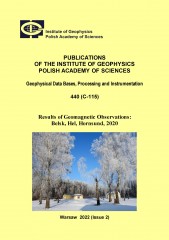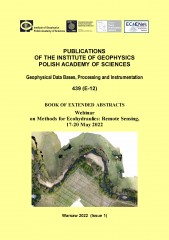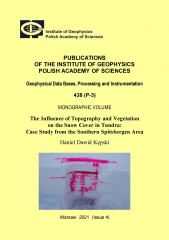BROWSE - VOLUME LIST
- A - Physics of the Earth's Interior
- B - Seismology
-
C - Geomagnetism
C-119, C-118, C-117, C-116, C-115, C-114, C-113, C-112, C-111, C-110, C-109, C-108, C-107, C-106, C-105, C-104, C-103, C-102, C-101, C-100, C-99, C-98, C-97, C-96, C-95, C-94, C-93, C-92, C-91, C-90, C-89, C-88, C-87, C-86, C-85, C-84, C-83, C-82, C-81, C-80, C-79, C-78, C-77, C-76, C-75, C-74, C-73, C-72, C-71, C-70, C-69, C-68, C-67, C-66, C-65, C-64, C-63, C-62, C-61, C-60, C-59, C-58, C-57, C-56, C-55, C-54, C-53, C-52, C-51, C-50, C-49, C-48, C-47, C-46, C-45, C-44, C-43, C-42, C-41, C-40, C-39, C-38, C-37, C-36, C-35, C-33, C-32, C-31, C-30, C-29, C-28, C-27, C-26, C-25, C-24, C-23, C-22, C-21, C-20, C-19, C-18, C-17, C-16, C-15, C-14, C-13, C-12, C-11, C-10, C-9, C-8, C-7, C-6, C-5, C-4, C-3, C-2, C-1
-
D - Physics of the Atmosphere
D-79, D-78, D-77, D-76, D-75, D-74, D-73, D-72, D-71, D-70, D-69, D-68, D-67, D-66, D-65, D-64, D-63, D-62, D-61, D-60, D-59, D-58, D-57, D-56, D-55, D-54, D-53, D-52, D-51, D-50, D-49, D-48, D-47, D-46, D-44, D-45, D-43, D-42, D-41, D-40, D-39, D-38, D-37, D-35, D-34, D-33, D-32, D-31, D-30, D-28, D-27, D-26, D-25, D-24, D-23, D-22, D-21, D-20, D-19, D-18, D-17, D-16, D-15, D-14, D-13, D-12, D-11, D-10, D-9, D-8, D-7, D-6, D-5, D-4, D-3, D-2, D-1
- E - Hydrology
- P - Polar Research
- M - Miscellanea
-
Online First
Browse - Volume list
Results of Geomagnetic Observations: Belsk, Hel, Hornsund, 2020
Author(s): Reda J., Neska M., Wójcik S., Czubak P.
Volume: 440
Series: C-115
DOI: 10.25171/InstGeoph_PAS_Publs-2022-018
Volume: 440
Series: C-115
DOI: 10.25171/InstGeoph_PAS_Publs-2022-018
This publication contains basic information on geomagnetic observations carried out in 2020 in three Polish geophysical observatories: Belsk, Hel, and Hornsund. IAGA codes are, respectively: BEL, HLP, and HRN. All these observatories belong to the Institute of Geophysics, Polish Academy of Sciences. Observatories Belsk and Hel are located on the territory of Poland, while Hornsund is in Spitsbergen archipelago, under Norwegian administration.
Book of Extended Abstracts. Webinar on Methods for Ecohydraulics: Remote Sensing, 17-20 May 2022
Author(s):
Volume: 439
Series: E-12
DOI: 10.25171/InstGeoph_PAS_Publs-2022-001
Volume: 439
Series: E-12
DOI: 10.25171/InstGeoph_PAS_Publs-2022-001
The present work aims to summarize the outcomes of the webinar on Remote Sensing in Ecohydraulics, co-organized by the Institute of Geophysics of the Polish Academy of Sciences, the IAHR Committee on Ecohydraulics, the IAHR Poland Young Professional Network and ECoENet.During the webinar, four keynote lectures and twelve technical notes, mainly coming from young researchers, provided the framework of the state-of-the-art of new tools, methods, equipment and methodologies for monitoring water habitats, and they aimed to share knowledge and address data survey needs.In terms of the geographical distribution of the abstracts, more than 10 countries were represented, showing the worldwide importance of the topic, and the willingness for developing international and transdisciplinary connections.
The Influence of Topography and Vegetation on the Snow Cover in Tundra: Case Study from the Southern Spitsbergen Area
Author(s): Kępski D.
Volume: 438
Series: P-3
DOI: 10.25171/InstGeoph_PAS_Publs-2021-041
Volume: 438
Series: P-3
DOI: 10.25171/InstGeoph_PAS_Publs-2021-041
The aim of the study was to identify the snow cover distribution in the southern Spitsbergen tundra environment and to quantify its relationship with the topography and land cover. This was achieved by correlating vectorized cartographic materials, modeled climatic parameters and calculated topographic indices with snow cover properties measured in the field and obtained using remote sensing techniques. An important source of information used in the analyzes was time-lapse photography, which, thanks to the developed methodology and created tools, allowed to obtain snow cover extent data characterized by high temporal and spatial resolution. Snow cover distribution in the immediate vicinity of the Polish Polar Station obtained from time-lapse material was related to the results of satellite image classification from the 2014 ablation season.
Achievements of the Institute of Geophysics, PAS: Annual Report 2020
Author(s):
Volume: 437
Series: M-35
DOI: 10.25171/InstGeoph_PAS_Publs-2021-043
Volume: 437
Series: M-35
DOI: 10.25171/InstGeoph_PAS_Publs-2021-043
This Monograph outlines the recent achievements of the Institute of Geophysics, Polish Academy of Sciences, focusing on the main strategic areas: Geosystem Processes, Earth Structure and Georesources, Anthropogenic and Natural Geohazards, Climate Change and Polar Research.
The publication is a reviewed and formatted version of the Annual Report 2020, providing information about the research done at the seven departments (Seismology, Atmospheric Physics, Lithospheric Research, Theoretical Geophysics, Hydrology and Hydrodynamics, Magnetism, Geophysical Imaging, and Polar and Marine Research), together with the Institute’s infrastructure, instrumentation, projects that have been completed or are under way, as well as editorial, educational and many other activities.
The publication is a reviewed and formatted version of the Annual Report 2020, providing information about the research done at the seven departments (Seismology, Atmospheric Physics, Lithospheric Research, Theoretical Geophysics, Hydrology and Hydrodynamics, Magnetism, Geophysical Imaging, and Polar and Marine Research), together with the Institute’s infrastructure, instrumentation, projects that have been completed or are under way, as well as editorial, educational and many other activities.
Achievements of the Institute of Geophysics, PAS: Annual Report 2019
Author(s):
Volume: 436
Series: M-34
DOI: 10.25171/InstGeoph_PAS_Publs-2021-042
Volume: 436
Series: M-34
DOI: 10.25171/InstGeoph_PAS_Publs-2021-042
This Monograph outlines the recent achievements of the Institute of Geophysics, Polish Academy of Sciences, focusing on the main strategic areas: Geosystem Processes, Earth Structure and Georesources, Anthropogenic and Natural Geohazards, Climate Change and Polar Research.The publication is a reviewed and formatted version of the Annual Report 2019, providing information about the research done at the seven departments (Seismology, Atmospheric Physics, Lithospheric Research, Theoretical Geophysics, Hydrology and Hydrodynamics, Magnetism, Geophysical Imaging, and Polar and Marine Research), together with the Institute’s infrastructure, instrumentation, projects that have been completed or are under way, as well as editorial, educational, and many other activities.






